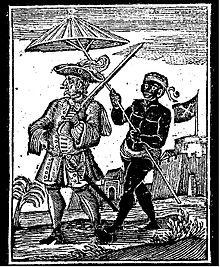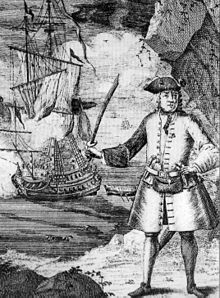Henry Every

Henry Every (* 1659 in Plymouth , † after October 1699 ) was an English pirate . He used various other names including a. John Avery, Long Ben and Benjamin Bridgeman. His nickname was The Arch Pirate ("the arch pirate"). His pirate flag shows a white skull on a black background ( Jolly Roger ) with a creole earring and a bandana , in profile with a view to the right, over two crossbones, on a black background. However, it is not certain whether this flag is authentic; neither a skull in profile nor a bandana or earring can be found on flags or other heraldic symbols of the time. Earrings, especially made of gold, were not uncommon among seafarers (the wearer hoped that the proceeds from the earring would pay him a Christian burial), but bandana and earring probably only became popular artistic details in the late 19th century Pirate representations, starting with the illustrated stories Howard Pyles (1853–1911).
Life
Early years
According to various reports, as a member of the Royal Navy, he was present at the bombing of the pirate base in Algiers in 1671. According to others, he was a buccaneer in Central America or a freighter captain of logs in the Bay of Campeche . According to other reports, he was a pirate under Captain Red Hand Nicholls in 1691 and 1692. But he could also have been a slave hunter in the service of the governor of Bermuda along the West African coast. Initially, Every began the unlicensed slave trade from the Bahamas . So there are different versions of his early years.
In any case, from June 1694 he was first mate on the Spanish privateer ship Carlos II , which was supposed to attack French smugglers on Martinique . However, after months of no wages paid, the crew grew angrier, and so Every led a mutiny near the Spanish city of La Coruña against Captain Gibson, who was sleeping off his intoxication and who was simply put ashore. Every was then appointed captain of the ship by the mutineers, which was renamed Fancy . The Fancy boarded three English ships near the Cape Verde Islands , sailed around Africa into the Indian Ocean and captured a French privateer ship near the island of Anjouan ( Comoros ). About 40 men from his crew signed on for the Fancy . At Anjouan ("Johanna") Every wrote his famous letter:
- To all English commanders.
- Suffice it to say that right now I am on the Fancy, a man-of-war [warship], previously known as Charles, which was part of the Spanish expedition and which departed from La Coruña on May 7, 1694 who, then and now, was a 46-gun, 150-man ship, about to seek happiness. I have not done anything against the English or the Dutch, nor do I intend to do so while I am the leader. Since I usually want to speak to all of the ships I come across and I don't want anyone harmed, and if you or anyone you are alerting wants to know who we are from a distance, then you should tie their flag in a ball and hoist it on the mast. So I will answer in the same way and not bother you, for my men are hungry for prey, steadfast and determined, and if the men do not follow my request, I cannot prevent it. Still a friend of the English
- At Johanna's on February 18, 1695
- Henry Every
- There are about 160 armed French men at Mohilla's waiting for the opportunity to get some ship, so be careful.
After this letter, a confrontation with English ships was inevitable. Near Guinea , West Africa, Every lured locals on the pretext of trading, only to rob them as slaves. So successful was he in his misdeeds that he was declared unworthy of royal pardon.
Pirate fleet
In mid-1695, Everys Fancy and another ship set course for the Red Sea. On the way they came across the Portsmouth Adventure , which they joined and on which the German Richard Sievers was as navigator. The three pirate ships lurked together on the Arab side of the Bab el-Mandeb , in a sheltered bay on the island of Perim , for the fleet with the pilgrims who sailed every year from the Mughal Empire to Mecca and back. During this waiting period, three more pirate ships finally joined them, led by Thomas Tew's Amity . The captains of the other ships were William Want , Thomas Wake , William May and Joseph Faro.
It was a nasty surprise for the pirates when they finally found out that they had been passed unnoticed by the pilgrims' fleet and that they were already on their way home. This was followed by a week-long chase, during which the pirate flotilla continued to fall apart. Soon only the Portsmouth Adventure could follow the two leading ships that Every commanded. However, it too was too slow to take an active part in the coup that made Every and his men famous and rich: the capture of the two pilgrim ships, Fateh Mohammed and Gang-i Sawai, laden with treasures . The Fateh Mohammed made little resistance and brought a 50,000 pounds. The Gang-i-Sawai was a huge ship with 62 cannons and 400 to 500 musketeers and 600 passengers on board. It lost its main mast when hit by Every and a cannon exploded on deck in its first volley. Due to poor leadership and the determination of the pirates, the ship had to surrender after two hours of hard fighting on deck.
The passengers and crews were tortured and raped so that they could reveal where the valuables were hidden. Some went overboard voluntarily or otherwise committed suicide. The search yielded 600,000 pounds in gold, silver and precious stones, as well as a saddle set with rubies, intended as a gift for the Great Mughal. After the pirates finished, they allowed the ship to drift away, but without the surviving women. They eventually returned to Surat . What happened to the passengers and crews is not known. It is believed that they were thrown overboard or landed in Réunion , where the pirates stopped to split the booty. This booty was one of the largest ever. Each man received over £ 1,000, the younger £ 500. Every got two shares as captain.
Caribbean
Soon afterwards the flotilla split up. Some of Every's men also left him, but he received replacements in the form of slaves before embarking for St. Thomas to sell more booty. Eventually he sailed to New Providence in the Bahamas . After buying protection from the Governor of the Bahamas, Nicholas Trott, for about £ 7,000 and having a grand celebration, he and his crew sailed for Jamaica in June 1695 and sought royal mercy from Governor William Beeston . They offered him £ 24,000 for it. Beeston refused, however, and so they returned to the Bahamas. Although the fancy had been turned over to the governor, the indifferent crew let the rundown ship run aground. Then everyone went their own way. Some went to America, others disappeared completely from the scene. The attack on the Gang-i-Sawai, however, angered the Mughal Mughal so much that he ceased trading with the British East India Company until it made reparations and offered a reward of £ 500 on each member of Every's crew. As a result, the force was not welcome in the West Indies and any other British colony.
The End
Every changed its name to Benjamin Bridgeman and put together some sloops to sail with the remaining crew to the British Isles. However, it was not the way of these men to go unremarkable, and so in October 1696 24 of them were arrested and six were hanged. Those who got away with their lives were deported to the American colonies. However, Every disappeared after arriving in Ireland and was never heard from again. There have been some reports that he was seen in Ireland, Scotland or Wales, and others that allegedly saw him on a tropical island. There is speculation that he retired and lived a luxurious life. Others say that while trying to sell gems he was betrayed, his fortune drained, and he was soon forced to beg for food and died penniless. What is certain, however, is that the capture of the Gang-i-Sawai inspired some men to turn to piracy.
Individual evidence
- ↑ Published in 1903 as the collection "Howard Pyle's Book of Pirates".
- ↑ Archive link ( Memento from January 15, 2008 in the Internet Archive )
literature
- Charles Johnson : A General History of the Robberies and Murders of the Most Notorious Pirates. London 1724/1728. Reprint: The Lyons Press, 2002, ISBN 1-58574-558-8 . ** German edition: Comprehensive history of the robberies and murders of the notorious pirates . Robinson, Frankfurt am Main 1982, ISBN 3-88592-009-3 .
- Robert Bohn : The pirates. 2nd edition Beck, Munich 2005, ISBN 3-406-48027-6 .
- Uncharted 4: A Thief's End [10. May 2016]
Web links
| personal data | |
|---|---|
| SURNAME | Every, Henry |
| ALTERNATIVE NAMES | Avery, John (pen name); Long Ben (pseudonym); Bridgeman, Ben (pseudonym) |
| BRIEF DESCRIPTION | English pirate |
| DATE OF BIRTH | 1659 |
| PLACE OF BIRTH | Plymouth |
| DATE OF DEATH | after October 1699 |

